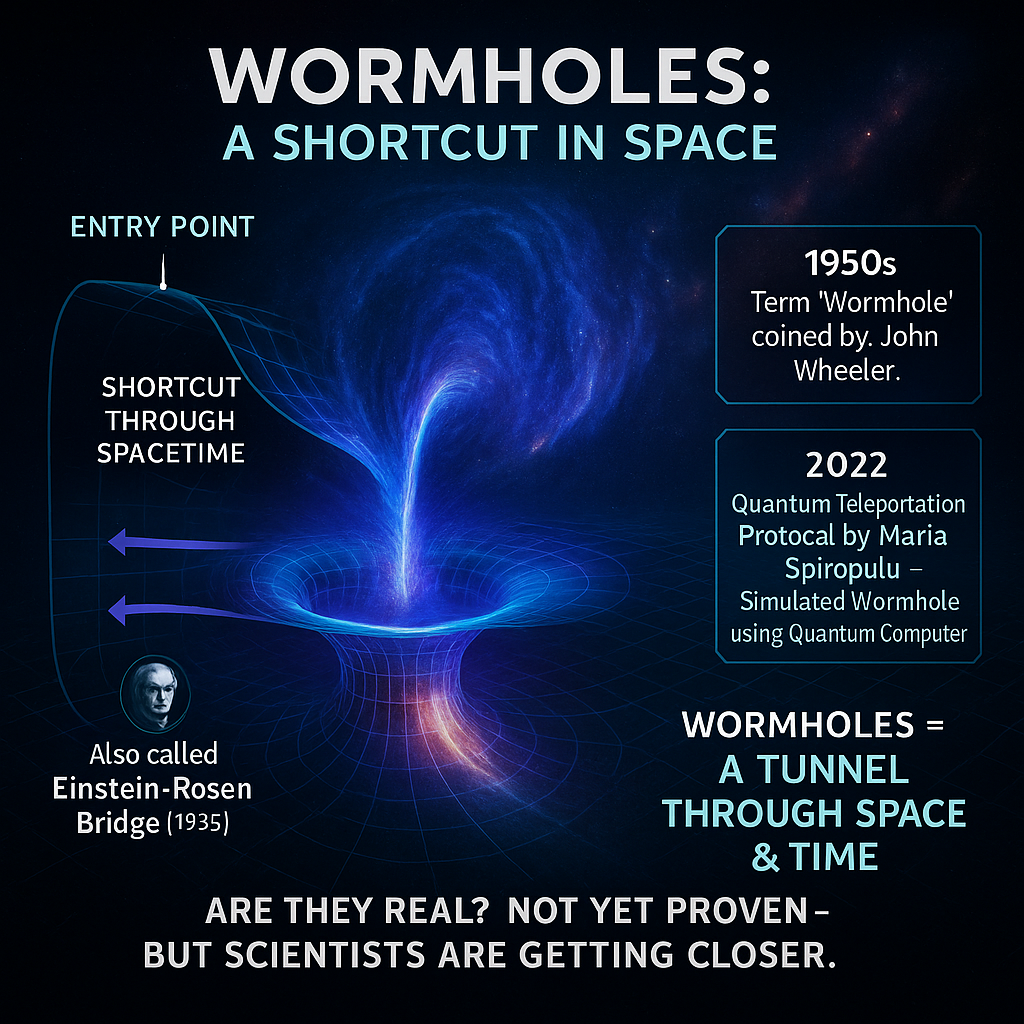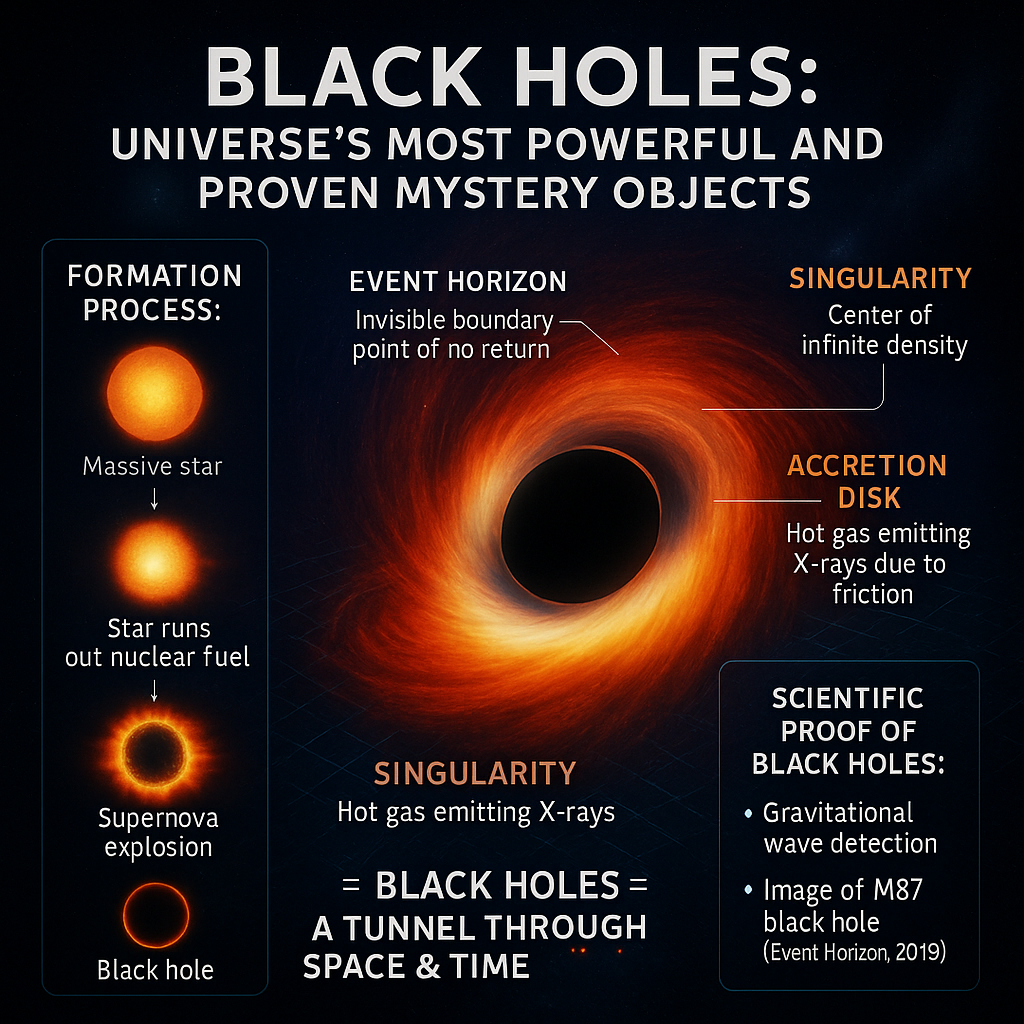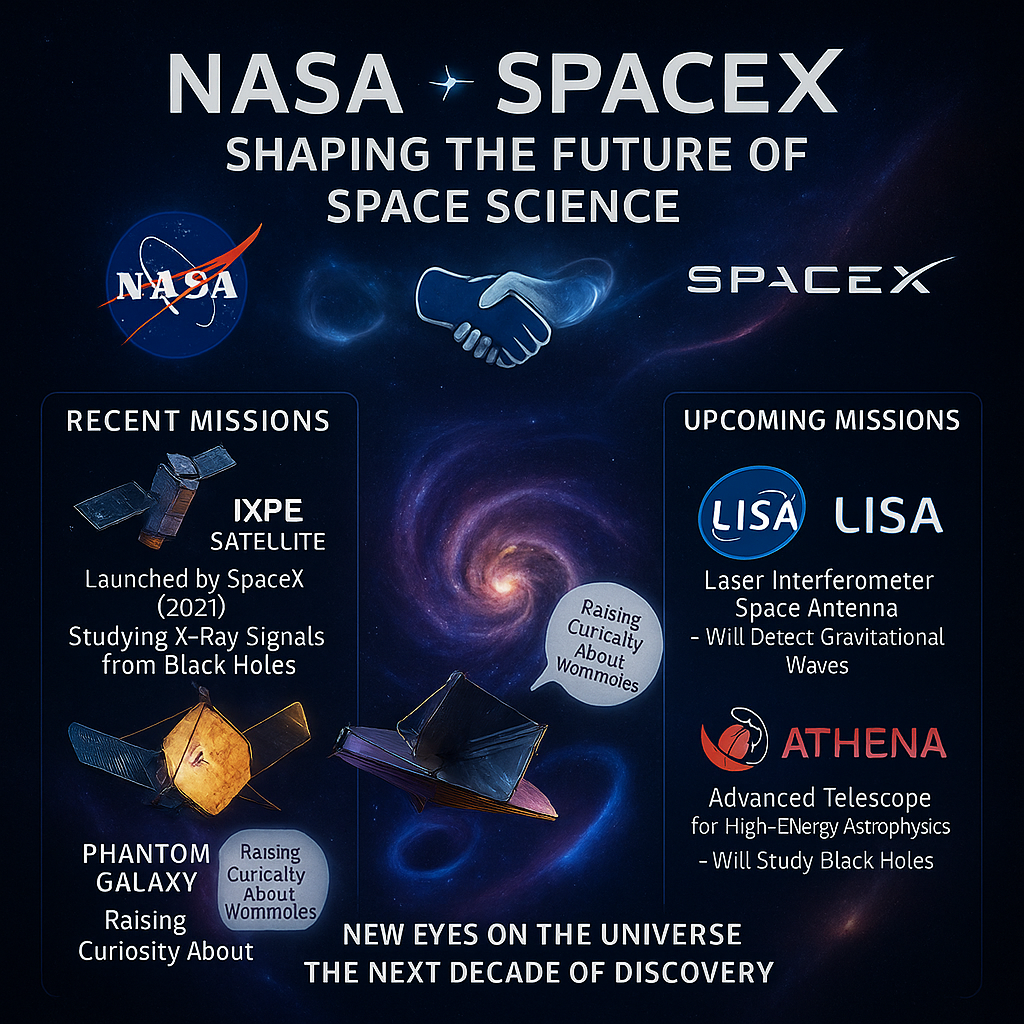Difference Between Black Hole Vs Wormhole
Wormholes Vs Black Holes: Understand These Mysterious Secrets Of Space
Wormholes And Black Holes – Both Are The Most Mysterious And Mind-Blowing Concepts Of Astronomy. Be It Dark Matter, Dark Energy, Radiation, Birth Of Stars And The End Or Motion Of Galaxies – Both These Phenomena Give Us Important Clues About The Deep And Hidden Secrets Of The Universe. But Wormholes And Black Holes Are Not The Same. Their Structure, Way Of Working, And Impact – Everything Is Different. If You Want To Understand The Real Mysteries Of Space, Then It Is Very Important To Understand Both These Concepts Well.
What Is A Wormhole?

Learn About A Fascinating Space Shortcut Wormholes Are Hypothetical Space Tunnels That Connect Two Different Points Of Spacetime — Be It Two Different Places, Different Times, Or Two Different Universes! Imagine, If You Could Travel From One Place To Another Faster Than Light — That Is The Idea Behind The Concept Of Wormholes. This Concept Is Also Called The Einstein-Rosen Bridge, Which Was Proposed By Albert Einstein And Nathan Rosen In 1935. The Word Wormhole Was First Used By John Wheeler In The 1950s.
Wormhole = A Shortcut In Space
Wormhole Is Like A Tunnel With Two Openings, Which Can Go To Different Locations, Times Or Dimensions Of Spacetime.
Are Wormholes Possible In Reality?
Till Date There Is No Solid Proof Of Wormholes, But Scientists Are Exploring This Possibility.
Latest Research Update:
In 2022, Scientist Maria Spiropulu Along With Her Team Designed A “Wormhole Teleportation Protocol” Using A Quantum Computer – Which Was Considered A Major Scientific Breakthrough.
Do Wormholes Exist?
What Are Wormholes? Easy Hinglish Breakdown Of Einstein-Rosen Theory
When Einstein And Rosen Combined Their General Relativity With Electromagnetic Theory, They Came Up With A Revolutionary Idea – Wormholes!
What Is The Meaning Of Electromagnetic Theory? James Clerk Maxwell’s Theory States That Light Waves Travel Through Electric And Magnetic Fields.
Quantum Field Theory (I.E. Electron Field Theory)
It Describes How Particles Behave And Interact In Space. In These Fields, Particles Move In A Fluid-Like Pattern – I.E. They Are Not Fixed. Journey From Black Hole To Wormhole Einstein And Rosen Based Their Famous Black Hole Formula – Schwarzschild Solution – On This Equation. This Equation Tells Us The Relation Between Radius And Time Of A Spherical Mass (I.E. Black Hole). But They Removed The Point From This Equation Where Gravity Becomes So Intense That Spacetime Breaks (Which Is Called Curvature Singularity). After That They Proposed: If Both Ends Of A Black Hole Are Connected Via A Tunnel, Then It Can Form A Wormhole – Which We Call Einstein-Rosen Bridge. There Is No Event Horizon In This Wormhole – I.E. Such A Boundary From Which Even Light Cannot Escape.
❓ Are Wormholes Real?
At The Theoretical Level, Wormholes Are Possible. But Till Now There Has Been No Actual Observation Of Any Wormhole. Still, Wormholes Are A Fascinating Research Topic In Astronomy, Through Which Scientists Try To Understand The Behavior Of Space, Time And Matter.
Types Of Wormholes
Main Types Of Wormholes:
Wormholes Are One Of The Most Mysterious Concepts In Space. Scientists Have Proposed Many Theoretical Types So Far —
But They Are Mostly Divided Into 4 Major Categories:
1. Non-Traversable Wormholes – Closed Paths
These Wormholes Collapse Only When A Particle Passes Through Them.
So, No Matter Can Travel Through Them. Just A Theoretical Idea.
2. Traversable Wormholes – Known Paths
These Wormholes Are Made Of Exotic Matter — Matter That Has Negative Energy Density.
Theoretically, A Human Or An Object Can Travel Through These Wormholes, Even Faster-Than-Light.
3. Intra-Universe Wormholes – A Shortcut In The Same Universe
These Wormholes Connect Two Different Points Of The Same Universe.
Think Of A Shortcut Built Between Two Ends Of Space – Like A Cosmic Tunnel.
4. Inter-Universe Wormholes – Connecting Two Different Universes
These Wormholes Connect Points Of Two Different Universes.
That Is, A Direct Portal From One Universe To Another Universe.
Special Types Of Wormholes These Main Categories Also Have Some Special Subtypes:
Lorentzian Wormholes (Non-Traversable)
Euclidean Wormholes
Lorentzian Wormholes Are Based On Einstein’s General Relativity, While Euclidean Wormholes Are Based On Particle Physics. John Wheeler Named Them In 1957, Based On Their Spacetime Manifolds.
Can A Time Machine Be Made From Wormholes?
If A Lorentzian Wormhole Can Be Kept Stable, Then Theoretically A Time Machine Can Be Made. The Concepts Of Time Travel Are Also Inspired By This Idea.
Wormholes: Both In Science And Science Fiction Wormholes Have Not Yet Been Directly Observed In Space, They Are A Mind-Opening Idea For Astrophysics. Till Date, Many Theories And Sci-Fi Movies Have Explored The Concepts Of Wormholes.
Potential Uses Of Wormholes
Wormholes: Is Time Travel And Instant Space Travel Possible?
The Concept Of Wormholes Has Moved From Science Fiction To Real Scientific Theories. According To Some Experts, Wormholes Can Be Such Hypothetical Tunnels That Instantly Connect Two Points Of Space-Time. Is Instant Travel Possible Through Wormholes?
If Wormholes Exist, Then With Them We Can: Travel From One Universe To Another Universe Instantly
Instantly Connect Two Distant Locations Of The Same Universe Move Between Different Moments Of Time Connect Between Different Dimensions Traveling At The Speed Of Light Means Movement Through Space And Time With Zero Delay.
Possible Benefits Of Wormhole Technology
Time Travel Can Become Reality The Path Of Interdimensional Communication Can Open Interstellar Travel Will Become Easy – It Can Prove To Be A Game-Changer For Research And Exploration If The Use Of Wormholes Becomes Possible, Then It Will Change The Understanding Of The Entire Universe.
But Is It Possible In Reality?
So Far Wormholes: Are Limited To Mathematical Models And Computer Simulations No One Has Observed A Real Wormhole In Nature Or The Lab Even If Wormholes Are Real: They Require Exotic Matter To Keep Them Stable – Which Carries Negative Energy And So Far Is Limited To Theory Gravitational Pull And Radiation Can Be So Intense That Human Travel Is Extremely Risky
Have You Developed An Interest In Science?
Absolutely! Despite All These Challenges, Wormholes Are A Fascinating Topic In Which Scientists Get A Chance To: Develop New Theories Explore Quantum Physics And Relativity Understand The Deeper Secrets Of Space-Time
What Is A Black Hole?

Black Holes:
Universe’s Most Powerful And Proven Mystery Objects Black Holes Are The Most Real And Proven Objects In Space Science – Their Existence Has Been Scientifically Confirmed With Much Stronger Evidence Than Wormholes. These Are Such Spherical Zones From Which Neither Light Nor Matter Can Escape – Once It Goes Inside, It Never Comes Back!
How Are Black Holes Formed?
When A Massive Star Uses Up All Of Its Nuclear Fuel, It Collapses. After This Collapse, A Supernova Explosion Takes Place. If The Mass Of The Remaining Core Is Too Much, It Becomes A Black Hole.
Key Features Of Black Holes:
Event Horizon: This Is The Invisible Boundary Beyond Which Nothing Can Return – Neither Light, Nor Time, Nor Signal.
Singularity: In The Center Of The Black Hole Is A Place With Infinite Density – Where Gravity Is So Powerful That Space-Time Is Torn Apart.
Accretion Disk: Around The Black Hole Is A Disk Of Glowing, Hot Gas – Which Emits X-Ray Radiation Due To Friction And Gravity.
Scientific Proof Of Black Holes:
1. Gravitational Waves
These Ripples Of Space-Time Are Detected By Observatories Like Ligo When Two Black Holes Collide And Merge.
2. Event Horizon Telescope Images
This Telescope Captured The Image Of Galaxy M87’s Black Hole For The First Time – From Which Even Light Does Not Come Out.
3. X-Ray Emissions
When An Object Enters The Accretion Disk Of A Black Hole, It Becomes Extremely Hot And Emits X-Rays – Which We Can Detect From Earth.
Physics Of Black Holes:
Understand Their Science In Simple Language
When We Go Inside A Black Hole (Theoretically), All Physical Laws Fail. Gravity Is So Powerful That Even Light Cannot Escape. This Powerful Gravitational Force Is Explained By Einstein’s General Relativity. According To This Theory, Massive Objects Bend Spacetime, Which Forms The Structure Of A Black Hole. Another Important Concept Is Schwarzschild Radius – That Is, The Boundary Of The Black Hole Beyond Which Nothing, Including Light, Can Escape. Understanding This Boundary Is Crucial For Understanding The Size And Behavior Of Black Holes.
Types Of Black Holes (Based On Mass)
Scientists Have Divided Black Holes Into 4 Categories, Based On Their Mass:
Intermediate-Mass Black Holes These Black Holes Have The Size Between Stellar And Supermassive Black Holes. Their Mass Can Be Equal To Hundreds To Thousands Of Suns. Primordial Black Holes These Are Theoretical Black Holes Which Are Believed To Have Been Formed At The Beginning Of The Universe After The Big Bang. Their Size Varies, But They Have Not Been Observed Yet.
Stellar-Mass Black Holes
These Are The Most Common Black Holes Which Are Formed When Massive Stars Collapse. Their Size Can Be From 5x To 20x The Sun.
Supermassive Black Holes
These Are Located At The Center Of Every Galaxy And Their Mass Ranges From Millions To That Of Arabian Suns. These Are The Largest Black Holes.
Which Black Holes Have We Observed?
Scientists Have Directly Observed Stellar-Mass And Supermassive Black Holes.
Research Is Still Underway On The Existence Of Intermediate-Mass Black Holes. If These Are Found, They Will Explain The Difference In Black Hole Sizes.
Primordial Black Holes Have Not Been Observed Yet, But Scientists Believe That They Formed At The Beginning Of The Universe And Have Mostly Evaporated By Now.
Effect Of Black Holes: Impact On Surroundings
The Gravitational Pull Of Black Holes Is So Powerful That They Pull The Matter Around Them Towards Themselves. When An Object Or Gas Comes Near Them, It Heats Up Tremendously, Due To Which X-Rays And Intense Radiation Are Emitted. This Is The Reason Why Black Holes Directly Impact The Formation And Development Of Stars And Galaxies.
Another Interesting Theory – Hawking Radiation – Says That Extra Radiation Can Also Be Emitted Due To Quantum Effects Near The Event Horizon Of A Black Hole.
This Means That Black Holes Lose Mass And Energy Over Time, And Can Also Evaporate One Day.
Black Holes Vs. Wormholes – What Is The Difference?
These Are Hypothetical Tunnels That Connect Two Different Points Of Space-Time.
They Have Never Been Observed So Far.
They Support The Theoretical Concept Of Faster-Than-Light (Ftl) Travel.
They Are Mentioned A Lot In Sci-Fi Movies And Research.
Black Holes
There Is Strong Scientific Proof Of Their Existence – Like Gravitational Waves And Telescope Images.
These Are Not Tunnels, But Dense Objects Formed After The Collapse Of Massive Stars.
Whatever Goes Inside A Black Hole Never Comes Out.
Structural Differences
Wormholes Theoretically Bend Spacetime, Allowing A Shortcut From One Place To Another.
Black Holes Also Distort Spacetime, But They Absorb Matter And Emit Intense Radiation.
Wormholes Do Not Have Curvature Singularities, While Black Holes Have Them In The Center Where Gravity Is So Strong That Both Space And Time Break Down.
Scientific & Future Technology Implications
Research On Wormholes Helps Us To Deeply Understand Space-Time And Quantum Physics.
If They Exist, They Could Open Up Futuristic Possibilities Like Ftl Travel, Time Travel And Interdimensional Communication.
This Is An Inspiring Concept For Quantum Breakthroughs.
The Study Of Black Holes Is Based On Real Observations, Which Helps Us Understand The Real Behavior Of Space, And Can Also Lay The Groundwork For Advanced Concepts Like Wormholes.
Latest Research & Future Possibilities:
In Search Of Wormholes And Black Holes
Today, Astrophysics Has Become A Fascinating Field For Scientists Around The World. Maria Spiropulu Of Caltech And Daniel Jafferis Of Harvard Simulated Wormhole Dynamics Using Quantum Computers — Which Is Considered A Revolutionary Step.
Leading Scientists Of Black Hole Research:
Roger Penrose – University Of Oxford
Reinhard Genzel – Max Planck Institute
Andrea Ghez – Ucla
All Of These Scientists Have Discovered “Black Hole Echoes,” Which Tell Us How Black Holes Originated And How They Evolve With Time.
In Addition, Prestigious Institutes Such As Nasa, Johns Hopkins University, And Rochester Institute Of Technology Are Actively Leading Cosmic Research.
Major Challenges And Ongoing Controversies
Astrophysics Is A Dynamic And Complex Field, Where Many Challenges And Scientific Debates Continue To Take Place.
Key Challenges:
It Is Not Possible To Safely Approach Black Holes. The Event Horizon Is Invisible, So Direct Observation Is Difficult. Simulations Of Wormholes And Black Holes Require High-Performance Computing — Which Can Be Costly And Environmental-Impacting.
Scientific Disagreements:
Scientists Believe There Is No Consensus Yet On Whether Black Holes Could Be A Source Of Dark Matter. There Is Also Disagreement Over Methods Such As Gamma-Ray Bursts Or Gravitational Lensing To Detect Wormholes.
Some Experts Even Doubt The Actual Existence Of Wormholes.
Future Breakthroughs That Could Change Space Science

In Some Upcoming Years, Nasa And Spacex Can Play A Very Big Role Together To Bring Advancement In Space Science.
Recent Missions:
In 2021, Spacex Launched Nasa’s Ixpe Satellite, Which Studies The X-Ray Signals Coming From Black Holes. The James Webb Space Telescope (Jwst) Has Captured Some Such Images — Like The Phantom Galaxy — Which Have Increased Scientific Curiosity About Structures Like Wormholes.
Upcoming Missions:
Nasa’s Lisa Mission
Esa’s Athena Mission
These Powerful Space Instruments Can Bring Groundbreaking Discoveries In The Study Of Black Holes And Wormholes In The Next Decade, Which Will Take Our Understanding Of The Universe To The Next Level.
